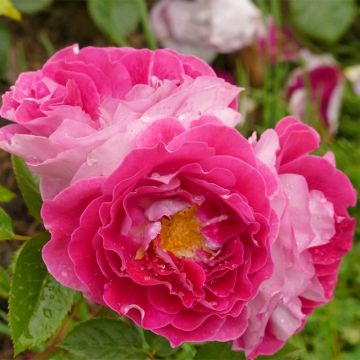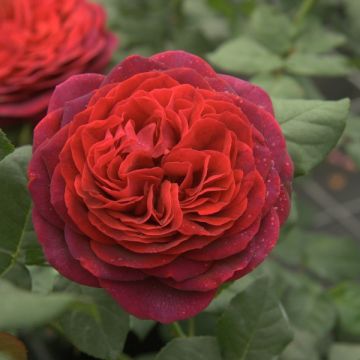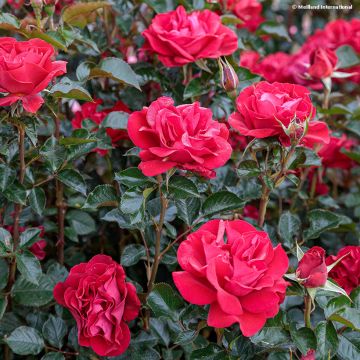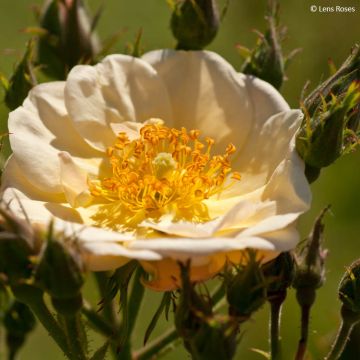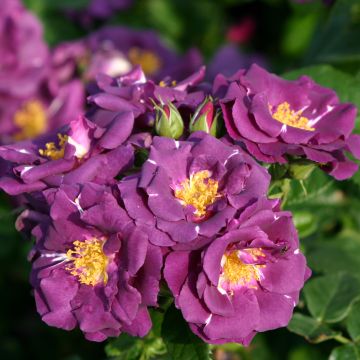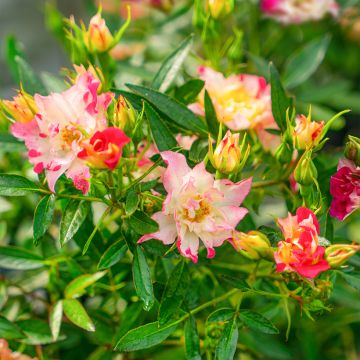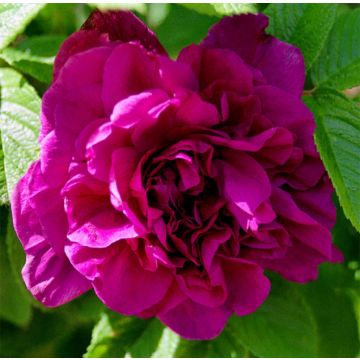

Rosa Chalon en Bourgogne - Floribunda rose
Rosa Chalon en Bourgogne - Floribunda rose
Rosa (x) floribunda Chalon en Bourgogne® (trascrivmichju)
Floribunda Rose
This item cannot be shipped to the selected country
Delivery charge from €5.90
Delivery charge from €5.90
Delivery to Corse prohibited
More information
Schedule delivery date,
and select date in basket
This plant carries a 24 months recovery warranty
More information
We guarantee the quality of our plants for a full growing cycle, and will replace at our expense any plant that fails to recover under normal climatic and planting conditions.
From €5.90 for pickup delivery and €6.90 for home delivery
Express home delivery from €8.90.
From €5.90 for pickup delivery and €6.90 for home delivery
Express home delivery from €8.90.
Delivery to Corse prohibited: UE law prohibits the import of this plant from mainland France to Corse as part of the fight against Xylella fastidiosa. Please accept our sincere apologies.
More information
Does this plant fit my garden?
Set up your Plantfit profile →
Description
Rosa Chalon en Bourgogne® 'trascrivmichju' is a moderate sized, vigorous variety of floribunda rose with excellent disease resistance. It offers carefully spiralled double flowers, grouped in clusters of 3 to 5 flowers. They are a beautiful cherry red, with a silver reverse and a white centre. This variety blooms continuously until October. Plant it in a flowerbed or mixed border.
The Rose Chalon en Bourgogne is a modern floribunda rose with large grouped flowers, compact and bushy in habit. It reaches about 80 cm to 1 m in height and 60 to 70 cm in spread at maturity, with rapid growth. This rose produces thorny branches that bear abundant foliage, cut into large, toothed, shiny dark green leaflets. Throughout the summer and until October, if faded flowers are removed, the plant continuously produces medium-sized double flowers, 8 cm in diameter, with the characteristic spiralled shape of Tea roses. Their colour is a shimmering cherry red, with a silver reverse and a white centre. The flowers are produced in small clusters at the end of the current year's long shoots or emerging on 2-year-old stems.
The Rose Chalon en Bourgogne is perfect for all gardens and gardeners, as it is easy to grow. Its moderate size allows it to be planted in small urban gardens or courtyards, as well as in larger gardens. It is ideal in perennial and shrub borders or colourful mixed borders. Pair its intense red colour with the light blue flowers of sages, nepetas, lavenders, or geraniums. Plant silver foliage artemisias at its base. Add medium-height ornamental grasses. Create a border with multiple bush roses.
Report an error about the product description
Plant habit
Flowering
Foliage
Botanical data
Rosa
(x) floribunda
Chalon en Bourgogne® (trascrivmichju)
Rosaceae
Floribunda Rose
Cultivar or hybrid
Other Polyantha clustered Roses
Planting and care
Plant the Chalon en Bourgogne floribunda rose from November to March, in ordinary, well-loosened and well-drained soil. Roses prefer clayey soils, rather heavy than light. In soil that is too sandy, too compact, or too dry in summer, it is preferable to place compost or decomposed manure at the bottom of the planting hole. However, this rose dislikes waterlogged soils in winter. Plant it in a sunny location, or at most in partial shade. Roses are hungry plants, so a specific fertiliser will be beneficial at the start of vegetation, and regularly throughout the flowering period.
To encourage reblooming, regularly remove faded flowers. Floribunda rose varieties are more vigorous and more floriferous than large-flowered rose varieties. Therefore, the stems should be pruned to about a quarter of their length (from 4 to 6 buds from the base of the stem) at the end of winter. Always prune above an outward-facing bud so that the bush can fill out and the branches do not become tangled in the centre.
Roses are often spotted or unsightly at the end of summer, but this is not a problem for their development. These spots are not harmful to the rose, it is a natural phenomenon.
Planting period
Intended location
Care
-
, onOrder confirmed
Reply from on Promesse de fleurs
Roses by purpose
Haven't found what you were looking for?
Hardiness is the lowest winter temperature a plant can endure without suffering serious damage or even dying. However, hardiness is affected by location (a sheltered area, such as a patio), protection (winter cover) and soil type (hardiness is improved by well-drained soil).

Photo Sharing Terms & Conditions
In order to encourage gardeners to interact and share their experiences, Promesse de fleurs offers various media enabling content to be uploaded onto its Site - in particular via the ‘Photo sharing’ module.
The User agrees to refrain from:
- Posting any content that is illegal, prejudicial, insulting, racist, inciteful to hatred, revisionist, contrary to public decency, that infringes on privacy or on the privacy rights of third parties, in particular the publicity rights of persons and goods, intellectual property rights, or the right to privacy.
- Submitting content on behalf of a third party;
- Impersonate the identity of a third party and/or publish any personal information about a third party;
In general, the User undertakes to refrain from any unethical behaviour.
All Content (in particular text, comments, files, images, photos, videos, creative works, etc.), which may be subject to property or intellectual property rights, image or other private rights, shall remain the property of the User, subject to the limited rights granted by the terms of the licence granted by Promesse de fleurs as stated below. Users are at liberty to publish or not to publish such Content on the Site, notably via the ‘Photo Sharing’ facility, and accept that this Content shall be made public and freely accessible, notably on the Internet.
Users further acknowledge, undertake to have ,and guarantee that they hold all necessary rights and permissions to publish such material on the Site, in particular with regard to the legislation in force pertaining to any privacy, property, intellectual property, image, or contractual rights, or rights of any other nature. By publishing such Content on the Site, Users acknowledge accepting full liability as publishers of the Content within the meaning of the law, and grant Promesse de fleurs, free of charge, an inclusive, worldwide licence for the said Content for the entire duration of its publication, including all reproduction, representation, up/downloading, displaying, performing, transmission, and storage rights.
Users also grant permission for their name to be linked to the Content and accept that this link may not always be made available.
By engaging in posting material, Users consent to their Content becoming automatically accessible on the Internet, in particular on other sites and/or blogs and/or web pages of the Promesse de fleurs site, including in particular social pages and the Promesse de fleurs catalogue.
Users may secure the removal of entrusted content free of charge by issuing a simple request via our contact form.
The flowering period indicated on our website applies to countries and regions located in USDA zone 8 (France, the United Kingdom, Ireland, the Netherlands, etc.)
It will vary according to where you live:
- In zones 9 to 10 (Italy, Spain, Greece, etc.), flowering will occur about 2 to 4 weeks earlier.
- In zones 6 to 7 (Germany, Poland, Slovenia, and lower mountainous regions), flowering will be delayed by 2 to 3 weeks.
- In zone 5 (Central Europe, Scandinavia), blooming will be delayed by 3 to 5 weeks.
In temperate climates, pruning of spring-flowering shrubs (forsythia, spireas, etc.) should be done just after flowering.
Pruning of summer-flowering shrubs (Indian Lilac, Perovskia, etc.) can be done in winter or spring.
In cold regions as well as with frost-sensitive plants, avoid pruning too early when severe frosts may still occur.
The planting period indicated on our website applies to countries and regions located in USDA zone 8 (France, United Kingdom, Ireland, Netherlands).
It will vary according to where you live:
- In Mediterranean zones (Marseille, Madrid, Milan, etc.), autumn and winter are the best planting periods.
- In continental zones (Strasbourg, Munich, Vienna, etc.), delay planting by 2 to 3 weeks in spring and bring it forward by 2 to 4 weeks in autumn.
- In mountainous regions (the Alps, Pyrenees, Carpathians, etc.), it is best to plant in late spring (May-June) or late summer (August-September).
The harvesting period indicated on our website applies to countries and regions in USDA zone 8 (France, England, Ireland, the Netherlands).
In colder areas (Scandinavia, Poland, Austria...) fruit and vegetable harvests are likely to be delayed by 3-4 weeks.
In warmer areas (Italy, Spain, Greece, etc.), harvesting will probably take place earlier, depending on weather conditions.
The sowing periods indicated on our website apply to countries and regions within USDA Zone 8 (France, UK, Ireland, Netherlands).
In colder areas (Scandinavia, Poland, Austria...), delay any outdoor sowing by 3-4 weeks, or sow under glass.
In warmer climes (Italy, Spain, Greece, etc.), bring outdoor sowing forward by a few weeks.

































